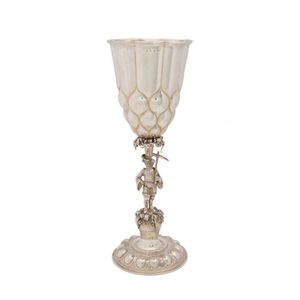Lalique Crystal Mesanges Vase, 31 cm High
You must be a subscriber, and be logged in to view price and dealer details.
Subscribe Now to view actual auction price for this item
When you subscribe, you have the option of setting the currency in which to display prices to $Au, $US, $NZ or Stg.
- Etched - Glass decorated with an etched design, which is achieved through marking out the pattern, protecting the area that is not be etched, and then immersing the object in acid to dissolve the surface of the unprotected area. With some glass objects, such as cameo glass, there may be several layers of different coloured glass, and part of the top layer is dissolved leaving the bottom layer as the background. The longer the time of exposure of the object to acid, the deeper the etching.
The word etching is also sometimes used to describe another method of decoration, where wheel grinders were used decorate the surface, but this technique is usually known as engraving. - Laurel Leaf - The use of the laurel leaf as a decorative element can be traced back to ancient Greece and Rome, where it was closely associated with victory and honour. In these cultures, the laurel was a sacred tree that was dedicated to the god Apollo and was believed to have protective and healing properties.
In ancient Greece, the laurel wreath was awarded to victors in athletic competitions, such as the Olympic Games, as a symbol of their achievement. The wreath was also associated with academic achievement, and was often worn by scholars and poets. The Greeks also used the laurel leaf as a symbol of victory in war, and it was often depicted in artwork alongside images of triumphant warriors and heroes.
The Romans continued this tradition, and the laurel wreath became a symbol of the highest military honor, the triumph, awarded to victorious generals. The wreath was also used to crown emperors and other important officials, and was often depicted in Roman art and architecture as a symbol of power and authority.
The laurel leaf is still used as a symbol of achievement, success, and excellence, and is frequently used in logos, emblems, and other branding materials. Its association with victory and honour has made it a popular choice for awards, medals, and other forms of recognition.
This item has been included into following indexes:
-
Lalique (France), item types
- other items 1,054
- vases 536
Visually similar items

A footed dish by Georg Jensen, styled in sterling silver, Gj monogram 925S Denmark sterling, reference 42D.

A Georg Jensen silver circular bowl, designed by Johan Rohde in 1912, Copenhagen, 1915/30, model No. 6, with a circular flared bowl raised on berried leaves and scrolls and stepped oval base, the base engraved 'Florence Stern Kahn - 1931', standard factory

Johan Rohde, sterling silver bowl, with grape and leaf pattern, of circular form with pierced stem depicting leaves and clusters of grapes on a spreading foot, design No. 197, impressed marks, manufactured for Georg Jensen, c. 1924, designed 1912. Diameter

A 16th century style sterling silver lobed chalice with Berthold Muller's import marks for London 1911, the stem in the form of William Tell, maker's mark of Ludgwig Neresheimer & co, Hanau marks. 28 cm high, 375 grams
